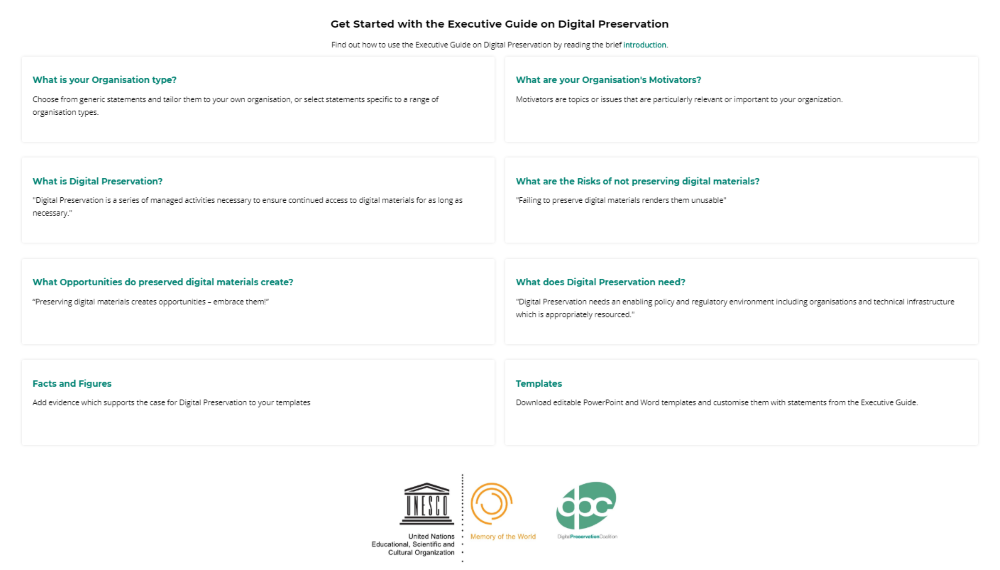The Digital Preservation Coalition (DPC) and United Nations Educational, Scientific and Cultural Organization Memory of the World PERSIST Project (UNESCO/MoW/PERSIST) have released their online Executive Guide on Digital Preservation today. The new resource provides practitioners with a combination of generic and specific messages and motivators designed to communicate with senior executives, legislators and budget holders, as well as decision and policy makers with a view to embedding the value of digital preservation at the core of every organization.
The development of the Executive Guide is supported by UNESCO/MoW/PERSIST whose member states each have a role in implementing the UNESCO Recommendation concerning the Preservation of, and Access to, Documentary Heritage Including in Digital Form. In order to support the UNESCO member states, and all organizations, in their mission to preserve our digital heritage the Executive Guide aims to be as broad reaching as possible.
“Users of the Executive Guide may belong to memory and heritage institutions, commercial organizations, government bodies and not-for-profits,” explains Rob Buckley, Coordinator for the UNESCO/MoW/PERSIST Policy Working Group. “However, recognizing that even within the same sector or member state, every organization is different, has different priorities, risk factors and motivators; the Executive Guide presents a set of generic and sector specific statements, which may be selected and tailored by individual organizations to assist in their own internal advocacy work.”
'It's a particular pleasure to release the Executive Guide coincides today with the meeting of Forum of National Archives and the International Council of Archives in Abu Dhabi, in company with Dr Abdullah Al Raisi, Director General of the National Archives of the United Arab Emirates.'
Interactive and customizable, the Executive Guide is an online and accessible collection of resources, available to all free of charge through the DPC website, and contains:
- Generic statements defining digital preservation in a range of clear, non-jargon terms which may be understood by various organization types
- Information relating to digital preservation in specific sectors and organization types
- A summary of the importance of digital preservation generally and specifically
- Key motivators for digital preservation which may be relevant to different organization types
- Risks and opportunities related to digital preservation
- Downloadable and customizable templates
- Useful links to related and relevant resources
- Statistics and evidence to be used in supporting the case for digital preservation
Each statement is associated with an organization type for which it might be most relevant. Currently the Executive Guide contains statements which have been created for (and by) Archives, Businesses, Higher Education and Research, Libraries, Museums and Galleries.

Users may interrogate the content by organization type, motivator or by browsing all statements before inserting into customizable PowerPoint or Word templates alongside evidence to support digital preservation, by way of statistics and case studies.
“The Executive Guide is a community developed and community owned resource,” explains Head of Advocacy and Communications for the DPC, Sarah Middleton. “The statements which make up the Executive Guide have been contributed by volunteer members of the DPC which represent just a small portion of the global digital preservation community. Nevertheless, it is hoped that it will be relevant to an international and cross-sector audience as much of the information is widely applicable and spans organization types and geography.”
Once the messages contained within the Guide have been tailored for use within a specific organization, customized messages are welcomed as updates for inclusion in future iterations of the resource, and their re-submission into the Guide is encouraged.
The Guide is a living and evolving resource which, with the submission of subsequent statements tailored to other organization types, will continue to grow and be relevant to the digital preservation community. This evolution is aligned with the fact that advocacy is not one single action, it is a lifecycle of actions and activities which must be repeated continuously in order be successful.
Recognizing the nature of this challenge, the DPC sees the benefit in sharing resources like the Guide which forms part of a suite of resources which are available free of charge and for the entire community – members and non-members alike. The Guide, and these other resources, support the entire advocacy lifecycle and aim to relieve some of the burden in engaging with decision-makers and executives on digital preservation.
About the Digital Preservation Coalition
The not-for-profit DPC is an international advocate for digital preservation, helping members around the world to deliver resilient long-term access to digital content and services through community engagement, targeted advocacy work, training and workforce development, capacity building, good practice and standards, and through good management and governance. Its vision is a secure digital legacy.
About the UNESCO Memory of the World PERSIST Project
In the PERSIST project, as part of the Action Plan for Strengthening the Memory of the World Programme (adopted by the 191th Executive board, objective 4a), UNESCO has joined forces with the International Council on Archives (ICA) and the International Federation of Library Associations and Institutions (IFLA) to provide a global platform with the convening and advocacy power of UNESCO.
In close cooperation with other stakeholders, the PERSIST project aims to enhance the sustainability of the information society by establishing continuity of preservation of and access to information. In doing so, PERSIST seeks to help secure important mechanisms of good governance and the right of access to knowledge and information. To accomplish this, PERSIST will work to establish cooperation and dialogue between governments, social organizations, and the IT-industry, and to create practical solutions in the area of sustainable digital preservation.












































































































































